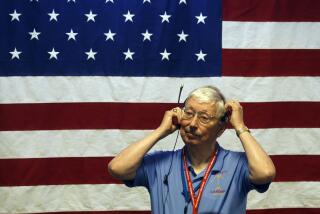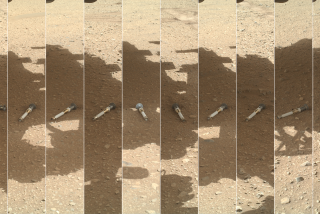Rover Curiosity lands safely: ‘Wheels down on Mars’
- Share via
Curiosity, the largest and most advanced spacecraft ever sent to another planet, stuck its extraordinary landing Sunday night in triumphant and flawless fashion, and is poised to begin its pioneering, two-year hunt for the building blocks of life — signs that Earth’s creatures may not be not alone in the universe.
NASA’s $2.5-billion mission involved the work of more than 5,000 people from 37 states, some of whom had labored for 10 years to hear the two words that Al Chen, a Jet Propulsion Laboratory engineer, said inside mission control at 10:32 p.m.: “Touchdown confirmed.”
Chen reported that Curiosity was in a “nice flat place,” and as icing on the cake, the spacecraft sent home thumbnail photographs of itself. Officials had said earlier in the day that photographs were possible but unlikely. Curiosity responded by immediately delivering a series of images, one showing one of its wheels resting comfortably on the floor of an ancient crater.
PHOTOS: JPL’s faces of joyInside mission control, engineers who had been chewing the insides of their cheeks and bouncing their legs nervously leapt to their feet, embracing, high-fiving and, in some cases, weeping with joy. “Yes!” one engineer cried, pumping his fist. “We did it again!” another shouted.
The striking success of the mission turned some steeped in hard science back into dreamers. JPL Director Charles Elachi said he walked outside mission control about an hour and a half before landing and stared up at Mars. “You are going to have a visitor,” Elachi said he whispered. “And the planet smiled,” Elachi said. “That’s when I knew.”
Curiosity is expected to revolutionize deep-space science, not only searching for indications that Mars is or was habitable, but paving the way for the next critical steps in exploration — soil-sample returns, sending astronauts to Mars, even, perhaps, colonization.
PHOTOS: A history of Mars exploration“It’s an extraordinary step forward in planetary exploration,” said John Holdren, President Obama’s science and technology advisor. “Nobody has ever done anything like this.” Anyone questioning the United States’ commitment to science and ambition should consider the “one-ton, automobile-sized piece of American ingenuity” that is now on Mars, Holdren said.
It had been a long and tense day at the Jet Propulsion Laboratory, which is managing the mission for NASA.
As scientists’ ambitions for Curiosity had grown in recent years, so had their spacecraft. This would not be a replay of the smaller rovers of the past -- which had, themselves, delivered extraordinary science and pretty firm evidence that rivers once coursed across the surface of Mars.
This would be a full-fledged geochemistry lab, on wheels, able to vaporize rocks, “taste” air samples and ingest dirt, then send the results of experiments home from 154 million miles away.
Curiosity’s size required engineers to devise an entirely new landing sequence. Thousands of carefully calibrated and experimental devices -- which could never be vetted on Earth because Mars’ atmosphere is so different -- had to work in precise lockstep for the spacecraft to survive.
The landing sequence, which NASA had dubbed “seven minutes of terror,” required the largest supersonic parachute ever deployed in space, a perilous-looking “sky crane” and 76 pyrotechnic explosions. If any one of those “pyros” had not occurred, “we die,” said Adam Steltzner, a leader of the landing team. Officials had spent much of the day Sunday speculating about how Curiosity might fail, and what the consequences might be for America’s space program.
“I was really on pins and needles,” said NASA Administrator Charles F. Bolden Jr. He called it a “huge day for the American people.”
“Everybody in the morning should be sticking their chest out saying: ‘That’s my rover on Mars,’” Bolden said.
The primary mission is expected to last for at least one Martian year, or 687 Earth days.
Previous NASA missions have found evidence that Mars, now a cold and dry planet, had a warmer, watery past, so much so that scientists think of it as Earth’s space cousin. Every environment on Earth that contains liquid water also sustains life. Curiosity will search for the other building blocks of life, particularly carbon-carrying organic molecules.
“Mars looks like it has been habitable,” said Michael Meyer, a leader of NASA’s Mars Exploration Program. “But you need to go and look.... And Curiosity is the rover that is able to do that.”
Other than the decision to send the robot to Mars in the first place, the choice of a landing site was probably the most important issue scientists faced.
For five years, space scientists made impassioned arguments for their favored site.
Last summer, from a pool of 60 candidates, NASA and JPL decided to send Curiosity to Gale Crater, an ancient geological feature just south of the equator, caused when a meteor slammed into Mars 3 billion years ago.
Gale Crater won out largely because of an enormous mountain in its center. Dubbed Mt. Sharp in honor of noted Caltech geologist Robert Phillip Sharp, the mountain is three miles high. That’s taller than any mountain in the “lower 48” of the United States, and taller than some portions of the rim of the crater that encircles the mound.
NASA’s Mars Reconnaissance Orbiter, a satellite that launched in 2005, has found that the mountain’s slopes contain distinct layers -- clay at the bottom, an apparent remnant of Mars’s watery past, a layer of sulfates on top of that, and layers of sand and dust toward the top.
Similar to the way the walls of the Grand Canyon offer a layered view of the evolution of North America, space scientists believe Mt. Sharp’s slopes contain a preserved record of Mars’s past.
Caltech’s John Grotzinger, Curiosity’s principal investigator, said the rover “will have started the era of a whole new dimension of space exploration.” That dimension, he said, is one of “deep time.”
Rather than getting a snapshot of one point in time on Mars, the mountain will allow Curiosity to build an understanding of “hundreds of millions to even billions of years,” Grotzinger said this weekend as JPL ramped up for landing.
Curiosity will climb the lower portion of the mountain to investigate the makeup of the layers of soil.
Times staff writers Amina Khan and Jon Bardin contributed to this report.







